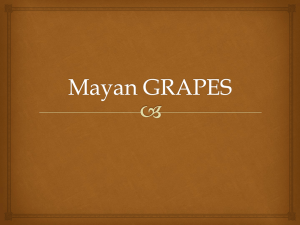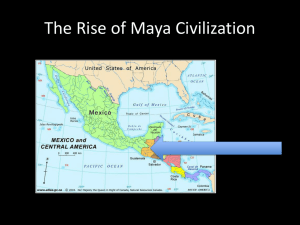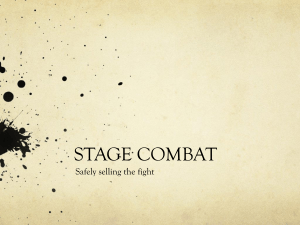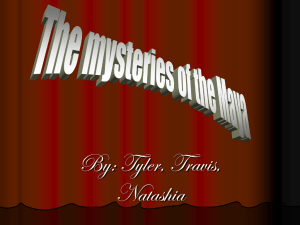God of War : How the Left and Right Brain learned to
advertisement
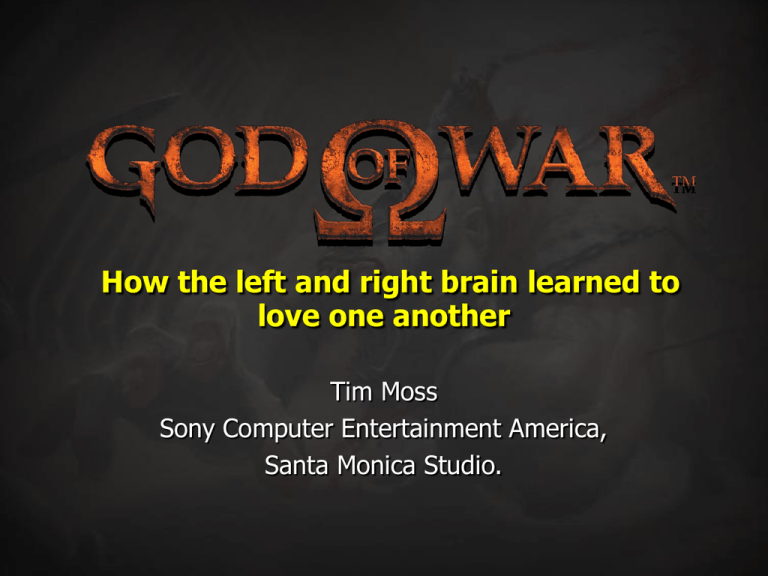
How the left and right brain learned to
love one another
Tim Moss
Sony Computer Entertainment America,
Santa Monica Studio.
Presentation Objectives
• Post Mortem
• Team Structure
• High level Summary of methods
Brief History
• Studio started in 1999
• ‘Fun Games that Sell’
• First project ‘Kinetica’
– An average game that sold averagely (But
had nice technology)
Objectives
• Establish a new Franchise for Sony
• A 3rd Person Action Platformer taking
the best elements of ICO, Devil May Cry
etc.
• Cinematic Camera
• Epic Story
• ‘Casual Hardcore’
Design Objectives
• Lots of special cases
• It should feel REALLY BIG.
• Feature creep…… don’t exactly know
what I want … but I will know it when I
see it.
• Game should keep moving, no obvious
repeats.
Programming Objectives
• 60 Frames Per Sec
• Technically outstanding on release.
• Build game / engine methodically, to avoid
wasting time and reduce bugs.
• Avoid special cases
• Prevent the programming department from
becoming a bottleneck
• Spend the last month of the project on the
beach while the game is being completed.
Bridging the Communication
Gap
•
•
•
•
Left brain / Right brain
Designers want special cases
Programmers hate special cases
Tools were the answer
Studio Layout
Open plan facts
• Facilitates conversation
• No-where to hide – so productivity
seems better. Can’t surf Ebay all day.
• You feel like you’re in a team.
• Headphones are vital.
• Difficult to avoid seagull management.
Team Structure
•
•
•
•
•
Code team (7)
Design team (10)
Art team (22)
Sound (3)
Production (4)
Code Team
• 7 Senior Programmers
• Broad responsibilities
• Usually a single point of contact for a
given system
Design Team
•
•
•
•
•
Game Director
4 Level Designers / Scripters
3 Combat Designers
2 Sound Implementers
1 Camera Designer
Art Team
•
•
•
•
•
Art
Art
Art
Art
Art
–
–
–
–
–
Environments (6)
Animation (5)
Characters (4)
Concept (3)
Technical Artists (4)
Technical Artists
• A group of 4 for GoW.
• Helped the Programmers structure the
tools.
• Helped design interfaces for the Maya
users.
• Troubleshooters
• Helped us avoid over-engineering.
Asset Creation based in
Maya
•
•
•
•
•
•
•
•
Art – Environments, Characters, Particles
Collision – Separate geometry from Art.
Camera Placement
Entity System (Scripting)
Sound / Music Triggers
Visibility Triggers
Loading Zone Triggers
Waypoint layouts
Asset Control
• Alienbrain …. Used simply as a file
structure system. Not at all customised.
That’s probably why it’s ok for us.
• The programmers didn’t use it for code.
Maya File structure
World
Cameras Entities Visuals Waypoints Sound
File Structure
• Allows multiple people to work on different
aspects of the same level.
• Common interface allows cross pollination of
responsibilities.
• Helps with bottleneck issues since chances
are higher that someone else can do any
given task.
Build Tools
• A single tool processes the .mb file
producing:– Binary chunks
– PERL Include Files
• Only changed pieces of scene are
rebuilt subsequently, the rest comes
from the cache.
• Complete Level data file is assembled
using a PERL script.
In Game Tweaking
• Some stuff can be edited in game
– Cameras
– Combat specifics
– Fog
• Saved to disk, included into the WAD
file on the next rebuild.
• Tweaks are checked into Alienbrain.
Easy workflow
• Every person has Maya installed, along
with the current build of game and tools
• Any person can build any asset of the
entire game on their own machine.
• Fast iteration time when editing specific
assets.
• No programmer intervention required.
Code Structure
• 3 time rule – if a request comes through 3
times, its probably something that’s really
wanted.
• Evaluate any serious design request with an
eye to adding a ‘feature’ to support it. Build it
in neatly and in as general way as possible.
• Don’t Hack EVER. You will pay for it later.
• HOWEVER – Resist the urge to over-engineer
Simple AI / Player
structure
• Common code for all enemies and the
player
• Navigation / Combat in 2 separate
systems so that 2 programmers could
work concurrently.
• Easier to debug
• Much less code
Navigation Code
• Objects represented by
a capsule.
• Line tests into the
collision to find
surfaces.
• Separate Physical
Position from actual
position to reduce pops.
• All characters use the
same code.
Combat / Move System
• Every single character in games used same Combat /
Move system, even the player.
• Designers could cut up anims
• Special tools to allow real-time tweaking of combat
from a PC.
• Branches setup to occur on :–
–
–
–
–
Hits from or to other chars
Environment hits
Timers
Button presses
Etc….
Combat / Move System
Details
•
•
•
•
•
•
Add sound effects
Add visual effects
Play at different speeds
Synchronize with targets
Add Button press triggers.
Track and Field Play back.
Player / AI
• Player :– Joypad converted into a Worldvector, this
drives motion
– Buttons control which combat moves are
called
• AI :– World Vector is calculated, used to drive
motion
– Decision Tree decides which move.
Waypoints
• Created using a tool in Maya
• Overlays a grid onto a Room in Maya.
• Designers can ‘paint’ accessible
gridsquares.
• Tool automatically sets up linkages.
• Enemies can then use this to navigate
through environment.
Synchronized Animations
• Player can synchronize animation with an object in
the environment.
• Puts the job of doing special case in the hands of the
animators and designers.
Synchronized Examples
• Cranks – Play a synced animation, and
player stays attached to the handle.
Handle can be moved anywhere by
animation.
• Lift Doors – Use track and field
mechanic.
• Combat – all over the place.
Entity System
• Annotation system for game levels
• Allows designers to add reactivity by
connecting "events" to "actions", e.g.
–
–
"pull lever" -> "open door"
"player in zone" -> "load next level“
• Designers create entities and zones.
Connect them and edit attributes in a
MEL based editor.
Entity System - Tools
• Various Entity Types
– Sensors – Detect Entry / Exit from zones, Creation / Destruction of
objects
– Actuators – Play Animations, Control visibility, create objects /
• Entities have attributes, some are common, some are custom
per type.
• Attributes may contain in-line script code, e.g.
– "Enabled: (GotShield && GotKey && ! DoorOpened)“
– "Execute: if (OnBeam) SetCamera ('OverheadCam')“
• Scripting is very simple in scope:
– if/else, int/float/string variables, built-in commands
– NO loops, user-defined functions
• Interconnection between entities is very limited:
– Sensors can only trigger actuators
– Many-to-1 and 1-to-many is allowed
Entity System - Game
• All creatures / objects have "markers"
that are tracked as they move through
"entity zones"
• This motion, as well as internal game
activity, give rise to messages that are
passed among entities
• Interpreting entity attribute scripts
changes the internal game state
Camera System
• Completely scripted
– No Collision
– No line of sight checks
• Set Design Level building strategy.
• Cameras can be controlled by the entity
system.
Camera System Contd
• Static – Fixed Position, Direction and FOV
• Animated
• Dynamic – constraints setup in maya. Actual
position calculated by game code.
• Action Zoom – Combat controlled, aims at
character, plays with FOV.
• Multiple cameras can run at once.
• Cameras can be overlapped to avoid rapid
switching.
Visibility System
• Entirely setup by hand.
• We always know where the camera is,
what its pointing at.
• Camera Position controls visibility.
Environmental Sound and
Music
• Sound effects can be added to
animations within Maya by a designer.
• Atmospheric sound zones can be placed
in a region.
• Music triggers can be done the same
way
Memory Management
32 Meg
memory
1.5
Meg
Exe
Run
Time
Data
Perm
Data
4*1 Meg
Enemies
16 Meg for Levels, split into 2
• Establish Hard Rules.
– 16 Meg for Level Data (Split into 2 Levels)
– 4 * 1 Meg for Enemies
Memory Management contd
• Let Art / Design do their own Memory
Management.
– Avoids Pigeon Holing anyone. Every level ends up
being a good compromise.
• Tools for memory tracking available in game.
– The artists frequently spotted memory leaks /
problems using this.
Level Loading Scheme
Load
Level B
Block
Level B
Level A
Block
Level A
Level B
Load
Level A
Level Loading Scheme
• 2 Levels loaded simultaneously. Either Current
Level and Last level, or Current and Next.
• Design places Load Triggers. These kick off a
level load.
• Also place Load Blocks.
• Simple rule – allow 1 sec of travel time for
every 1 meg of level that needs to load.
• 4 enemy slots also changed out at Level Load
time.
Flash
• All Front End and HUD elements done
using Flash. Heavily optimized for the
engine.
• Compiler is freely available on website.
• Allows prototyping and design without
programmer.
Optimising for Speed
• Frame rate is displayed front and center
to everyone, 60fps regarded as the
100% CPU and GS.
• Lead Programmer hassles them
endlessly about 60fps.
• The Frame Rate lies to everyone
Scheduling
• Overall Task List for the whole project,
broken down by programmer.
• Updated regularly
• Only added time estimates for what was
being done next.
• ‘Bang for the Buck’ approach.
Did it work?
• Executable for God of War was 1.5
meg. No code loading was done.
• General code made the game small,
more cache efficient. Ran faster.
• Engine / Tools are being used again on
GOW2. Also moving on to our PS3
titles.
Testing / Debugging
• 500 Bugs in database 2 weeks from
Gold Master. 25 were Programmer bugs.
• Led to a more bug free game – no
single group was overwhelmed.
Summary
• Programmers don’t drive game
development like the old days
• Expect more from Art and Design. They
can cope with it.
• Programmers are able to provide a
logical ‘left brain’ structure to the
project that the creative ‘right brain’
types aren’t even aware of.


